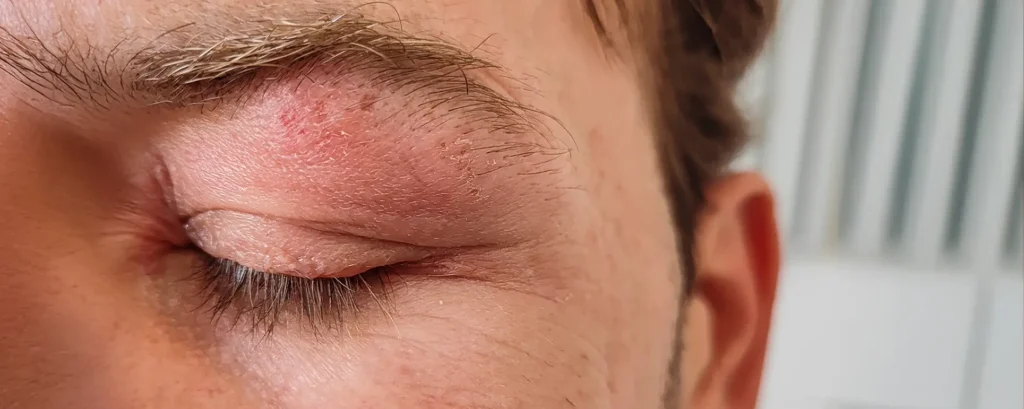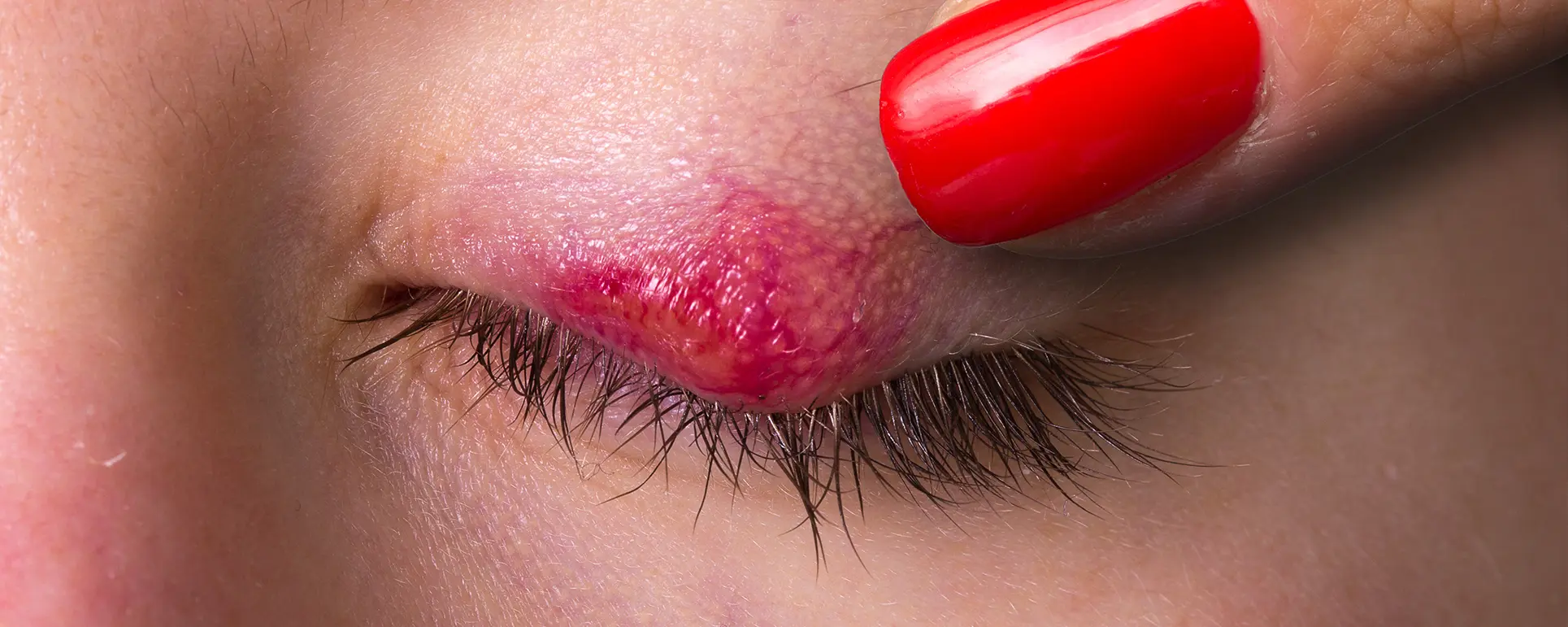Eyelid dermatitis is one of the most common and frustrating skin problems people experience around the eyes. It can cause redness, itching, swelling, dryness, and irritation that not only feels uncomfortable but also affects appearance. Because the skin on the eyelids is thinner and more delicate than other parts of the face, it is far more sensitive to external triggers. Even small amounts of certain ingredients in makeup, skincare, or personal care products can set off a reaction.
Many people first notice symptoms after applying eyeshadow, eyeliner, mascara, or facial creams, but the cause isn’t always obvious. Sometimes, it may not even be the product directly applied to the eyelid fragrances, preservatives, or nail polish ingredients transferred from your fingers can also be responsible. To make matters more complicated, reactions may not appear immediately. In some cases, irritation develops hours or even days later, making it harder to link the symptoms to a specific product.
Because of this, identifying the exact trigger can be challenging and time-consuming. Some people spend months swapping products or avoiding entire categories of skincare and makeup, only to find the problem persists. This trial-and-error approach can be frustrating and may even worsen the condition if the wrong products are used.
Dermatologists, however, have effective diagnostic tools to help patients get to the root cause. Through a careful medical history, examination of daily routines, and specialised tests like patch testing, they can narrow down potential allergens or irritants. Once the culprit is identified, dermatologists can recommend safer alternatives, soothing treatments, and long-term prevention strategies to keep flare-ups under control.
Seeking professional help early not only shortens the process of finding the trigger but also helps protect the delicate eyelid skin from long-term damage. Left untreated, repeated flare-ups can lead to chronic irritation, thickening of the skin, and even infections from constant scratching or rubbing. With the right guidance, most people can successfully manage eyelid dermatitis and return to using skincare and makeup with confidence, without the constant worry of unpredictable reactions.
In addition to treatment, dermatologists often educate patients on how to read ingredient labels and recognise common triggers, such as fragrances, preservatives, or certain metals found in cosmetics. This knowledge empowers individuals to make informed choices when purchasing makeup and skincare, reducing the risk of future flare-ups. Over time, this proactive approach not only helps in preventing eyelid dermatitis but also builds a healthier, more sustainable routine for sensitive skin.
Common Triggers of Eyelid Dermatitis

Makeup Ingredients
Makeup is one of the most frequent and well-recognised causes of eyelid dermatitis. Products like eyeshadows, mascaras, eyeliners, and concealers often contain fragrances, preservatives, stabilisers, and synthetic dyes that can irritate the thin, delicate eyelid skin. The eyelids have fewer oil glands than the rest of the face, which makes them more vulnerable to external chemicals. Waterproof mascaras and long-wear eyeliners, while popular for their staying power, often include harsher solvents and waxes that can trigger sensitivity in people with already delicate skin.
In many cases, it’s not the main pigment that causes the problem but rather the “hidden” ingredients such as parabens (preservatives), formaldehyde releasers, or fragrance compounds that are added for scent. For some individuals, irritation appears quickly within hours of applying makeup whereas others may only notice symptoms after repeated or long-term use. This makes it particularly difficult for people to identify the exact trigger. Dermatologists often see patients who believe they have reacted to one product but are, in fact, reacting to a single common ingredient that appears across many different brands. To make matters more complex, reactions can sometimes occur even with “hypoallergenic” or “natural” makeup products, since these may still contain botanical extracts or essential oils that irritate sensitive eyelid skin. Careful patch testing is often the only reliable way to pinpoint which specific ingredient is responsible and prevent unnecessary avoidance of safe products.
Skincare Products
Skincare products designed to rejuvenate or exfoliate the skin are another common culprit for eyelid dermatitis. Moisturisers, serums, and cleansers often contain active ingredients such as retinoids, alpha-hydroxy acids (AHAs), beta-hydroxy acids (BHAs), vitamin C, or essential oils. While these are effective on the cheeks or forehead, they can be far too strong for the fragile eyelid skin. Even products that are not applied directly to the eyelids can migrate to the area during sleep or when rubbing your face, unintentionally causing irritation.
For example, a night cream containing retinol applied near the eye area may improve wrinkles on the face but leave the eyelids red, flaky, or stinging. Similarly, cleansers with salicylic acid can drip onto the eyes while washing, leading to dermatitis flare-ups. Natural or “organic” products aren’t always safer either essential oils like lavender, peppermint, and tea tree can be highly irritating for sensitive eyelid skin. Some dermatologists even point out that overuse of “anti-ageing” products in the eye area is one of the most common self-inflicted causes of eyelid dermatitis. This shows why dermatologists often recommend fragrance-free, gentle skincare when dealing with persistent eyelid dermatitis, and why patch testing new products on less sensitive areas first can help prevent painful flare-ups.
Contact Allergens
Sometimes, the problem isn’t makeup or skincare at all but indirect allergens that come into contact with the eyelids. Nickel, a metal found in everyday items such as eyelash curlers, spectacle frames, jewellery, or even makeup applicators, is one of the most well-documented irritants. Even small traces of nickel can trigger allergic reactions in sensitive individuals, leading to itchy, red eyelids.
Cosmetic treatments may also introduce allergens. Certain eyelid masks, adhesive strips used in beauty procedures, or lash extension glues often contain formaldehyde or acrylates, which are strong sensitising agents. Surprisingly, even nail polish can play a role. When you touch or rub your eyes, tiny amounts of polish or remover can transfer to the eyelid skin, causing dermatitis. Many people are unaware of this connection and continue to react until a dermatologist helps them identify the hidden allergen. For this reason, patch testing or switching to nickel-free, hypoallergenic tools can make a significant difference. Understanding that allergens don’t always come from the products applied directly to the eyes is often a turning point in successful treatment.
Environmental Factors
The environment is another significant trigger that can worsen or even initiate eyelid dermatitis. The thin skin around the eyes is exposed daily to airborne irritants such as dust, cigarette smoke, pollution, pet dander, and pollen. These particles can easily settle on the skin, especially when combined with makeup or skincare products already applied to the eyelids, making irritation more severe.
Seasonal allergies also play a big role. During spring or summer, when pollen counts are high, many people with hay fever find that their eyelids become red, itchy, and swollen. Rubbing the eyes in response to the irritation only makes the condition worse, sometimes leading to repeated flare-ups. For individuals living in busy, polluted cities, exposure to smog and fine dust particles can trigger persistent dermatitis, particularly if they already have sensitive skin. The combination of environmental factors and cosmetic products can create a cycle of irritation that is difficult to break without professional advice.
How Dermatologists Diagnose Eyelid Dermatitis

Patch Testing
One of the most reliable diagnostic tools used by dermatologists is patch testing. This process involves applying small adhesive patches that contain trace amounts of common allergens such as preservatives, fragrances, dyes, or metals onto the patient’s skin, usually on the back or the upper arm. These patches remain in place for 48 hours and are then removed so the dermatologist can examine the skin for any reaction. If redness, swelling, or itching appears in one or more of the spots, it provides a clear indication of which ingredient is responsible.
Patch testing is especially important for eyelid dermatitis because the culprit often hides in unexpected products. For example, an ingredient in your shampoo, nail polish, or laundry detergent may be the real trigger even though you only notice irritation around the eyes. Many patients are surprised to learn that allergens can transfer indirectly, such as from their hands to their eyelids when they rub their eyes. By pinpointing the exact allergen through patch testing, dermatologists can offer specific guidance on which ingredients to avoid and often recommend safe, allergen-free alternatives.
Medical History Review
Beyond physical tests, dermatologists also carry out a thorough review of your medical and lifestyle history. They ask about your daily skincare routine, the makeup products you use, any recent changes in your personal care regimen, and how frequently symptoms appear. They also look at patterns such as whether the irritation occurs only at certain times of the year, after specific activities, or in particular environments.
Occupational and lifestyle factors are equally important. For example, a teacher who handles whiteboard markers daily, a painter exposed to chemical solvents, or a beautician working with adhesives for lash extensions may unknowingly come into contact with irritants that trigger dermatitis. Similarly, people with hobbies like gardening, swimming, or even frequent cooking may face repeated exposure to allergens or irritants. By piecing together this history, dermatologists form a comprehensive picture of your risk factors, which guides them in both diagnosis and treatment.
Elimination Method
Sometimes, even after patch testing and lifestyle review, the exact trigger remains elusive. In such cases, dermatologists often turn to the elimination method. This involves gradually removing potential irritants from your routine and observing whether symptoms improve. For example, a patient may be advised to stop using all eye makeup and skincare products for a few weeks. Once the eyelids calm down, products can be reintroduced one at a time.
If the dermatitis flares up after a particular product is reintroduced, it strongly suggests that product or an ingredient in it is the cause. Though it requires patience, this step-by-step process is extremely effective in identifying hidden irritants. Dermatologists often combine the elimination method with diary-keeping, encouraging patients to log what they used, when they used it, and how their skin reacted. This careful documentation helps establish patterns and eliminates guesswork.
Treatment & Safe Product Swaps
Topical Treatments
The first step in treating eyelid dermatitis is usually topical medication to reduce inflammation and discomfort. Dermatologists often prescribe mild corticosteroid creams for short-term use, which can quickly calm redness, swelling, and itching. However, because eyelid skin is delicate, stronger steroids are typically avoided to prevent side effects such as thinning of the skin or the development of fine blood vessels.
In cases where long-term management is needed, non-steroidal anti-inflammatory creams such as calcineurin inhibitors (tacrolimus or pimecrolimus) are often recommended. These are particularly valuable for chronic or recurrent cases, as they provide relief without the risks associated with steroids. Alongside medication, prescription moisturisers formulated for sensitive or eczema-prone skin are commonly used. These products strengthen the skin’s barrier, lock in moisture, and reduce the chance of flare-ups. Dermatologists may also recommend eye-safe emollients enriched with ceramides, glycerin, or hyaluronic acid to keep the area hydrated.
Product Swaps
Another crucial part of management involves making smart product substitutions. Dermatologists usually recommend switching to fragrance-free, hypoallergenic makeup and skincare products. These are less likely to contain harsh preservatives or sensitising agents. Products labelled as “ophthalmologist-tested” or “allergy-tested” are often safer choices for people prone to eyelid dermatitis.
Heavy eye creams that contain retinoids, AHAs, or strong essential oils should be avoided, especially during flare-ups, as they can aggravate sensitive eyelid skin. For makeup, mineral-based products or formulations designed for sensitive eyes are often suggested. Waterproof mascaras and long-lasting eyeliners, though convenient, often contain harsher chemicals that can increase the risk of irritation. Dermatologists also highlight the importance of regularly replacing old or expired products, since expired formulas can harbour bacteria or degraded ingredients that irritate the skin further.
Preventive Measures
Treatment doesn’t end once symptoms improve prevention is equally important to avoid recurring flare-ups. Dermatologists often stress the value of patch testing new products on less sensitive areas such as the inner wrist or behind the ear before applying them to the eyelids. This simple precaution can save patients from a painful reaction later.
Daily skincare habits also play a significant role. Gentle cleansing is essential: makeup and skincare products should be thoroughly but carefully removed to avoid residue buildup. Harsh scrubbing or strong cleansers should be avoided; instead, micellar water or mild, fragrance-free cleansers are recommended. Other preventive habits include avoiding frequent rubbing of the eyes, cleaning makeup brushes regularly, and staying mindful of environmental triggers like dust, smoke, or pollen.
For patients with seasonal allergies, dermatologists may also suggest antihistamine drops or other allergy management strategies to control symptoms before they affect the eyelids. Over time, these preventive measures, combined with safe product choices, can dramatically reduce the frequency of flare-ups and help patients maintain healthy, comfortable eyelid skin.
Final Thought: Getting to the Root of Eyelid Dermatitis
Eyelid dermatitis may look like a small irritation at first, but it can be surprisingly disruptive. Redness, itching, or swelling around the eyes not only causes physical discomfort but can also affect your confidence in daily life. Left untreated, the condition may recur frequently or even worsen over time, especially if the underlying trigger is not properly identified. That’s why professional evaluation is so important self-diagnosis and constant product switching often prolong the problem instead of solving it.
Dermatologists bring clarity to what can otherwise feel like a frustrating cycle of trial and error. With the help of techniques such as patch testing, elimination methods, and medical history review, they can pinpoint the exact cause and build a treatment plan tailored to your skin’s needs. Beyond prescribing safe topical treatments, they can also guide you on long-term preventive measures, including which makeup and skincare products to use, which to avoid, and how to maintain healthy eyelid skin.
If you’ve been struggling with persistent irritation, don’t ignore it or simply cover it up with makeup. Getting the right advice at the right time can make all the difference. You can get in touch with us to book a consultation with an experienced dermatologist in London who specialises in managing eyelid dermatitis. With expert care, you’ll not only find relief from your current symptoms but also gain the knowledge and confidence to keep flare-ups under control in the future.
References:
- Turkiewicz, M., Shah, A., Yang, Y. W., Mangold, A. & Shen, J. (2023). Allergic contact dermatitis of the eyelids: An interdisciplinary review. Ocular Surface, 28, pp. 124–130. DOI: 10.1016/j.jtos.2023.03.001. https://pubmed.ncbi.nlm.nih.gov/36898500/
- Rubegni, G., Padula, T., Calabrese, L., D’Onghia, M., Tognetti, L., Cinotti, E., Lazzeri, L., Ermini, G., Cartocci, A. & Tosi, G. M. (2025). Eyelid Contact Dermatitis: 25-Year Single-Center Retrospective Study. Journal of Clinical Medicine, 14(3), 823. DOI: 10.3390/jcm14030823. https://pmc.ncbi.nlm.nih.gov/articles/PMC11818699/?utm_source=chatgpt.com
- Huang, C. X., Yiannias, J. A., Killian, J. M. & Shen, J. F. (2021). Seven common allergen groups causing eyelid dermatitis: Education and avoidance strategies. Clinical Ophthalmology, 15, pp. 1477–1490. DOI: 10.2147/OPTH.S297754. https://pubmed.ncbi.nlm.nih.gov/33880007/
- Warshaw, E. M., et al. (2021). Eyelid dermatitis in patients referred for patch testing: Retrospective analysis of North American Contact Dermatitis Group data, 1994–2016. Journal of the American Academy of Dermatology, 84(4), pp. 953–964. DOI: 10.1016/j.jaad.2020.07.020. https://pubmed.ncbi.nlm.nih.gov/36898500/
- Contact allergens responsible for eyelid dermatitis in adults (2024). Japanese Dermatological Association. https://pubmed.ncbi.nlm.nih.gov/38351529/
